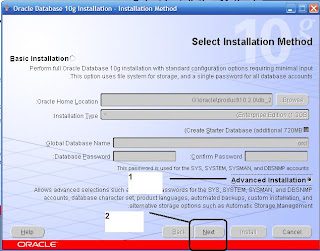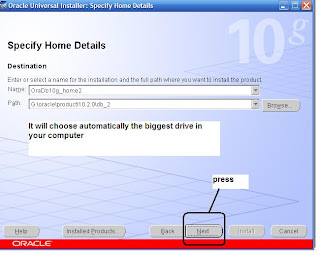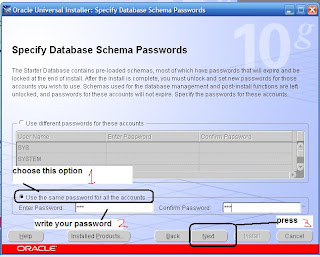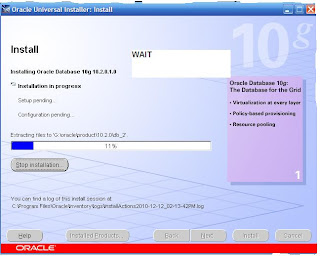To know how to setup Oracle 10g Database
2010/12/12
What is Program-Data Independence?
Techniques that allow data to be changed without affecting the applications that process it. There are two kinds of data independence. The first type is data independence for data, which is accomplished in a database management system (DBMS). It allows the database to be structurally changed without affecting most existing programs. Programs access data in a DBMS by field and are concerned with only the data fields they use, not the format of the complete record. Thus, when the record layout is updated (fields added, deleted or changed in size), the only programs that must be changed are those that use those new fields.
Reference: http://www.answers.com/topic/dataindependence#ixzz164riqgP2
Reference: http://www.answers.com/topic/dataindependence#ixzz164riqgP2
2010/12/11
How to make Jar file
Download How to make Jar file FROM HERE
How to make calender in oracle
Download How to make calender in oracle FROM HERE
Database
From Wikipedia, the free encyclopedia
This article is about managing and structuring the collections of data held on computers. For a fuller discussion of DBMS software, see database management system. For databased content libraries, see online database. For other uses, see Database (disambiguation).
A database consists of an organized collection of data for one or more uses, typically in digital form. One way of classifying databases involves the type of their contents, for example: bibliographic, document-text, statistical. Digital databases are managed using database management systems, which store database contents, allowing data creation and maintenance, and search and other access.
Architecture
Database architecture consists of three levels, external, conceptual and internal. Clearly separating the three levels was a major feature of the relational database model that dominates 21st century databases.[1]
The external level defines how users understand the organization of the data. A single database can have any number of views at the external level. The internal level defines how the data is physically stored and processed by the computing system. Internal architecture is concerned with cost, performance, scalability and other operational matters. The conceptual is a level of indirection between internal and external. It provides a common view of the database that is uncomplicated by details of how the data is stored or managed, and that can unify the various external views into a coherent whole.
Database management systems
Main article: Database management system
A database management system (DBMS) consists of software that operates databases, providing storage, access, security, backup and other facilities. Database management systems can be categorized according to the database model that they support, such as relational or XML, the type(s) of computer they support, such as a server cluster or a mobile phone, the query language(s) that access the database, such as SQL or XQuery, performance trade-offs, such as maximum scale or maximum speed or others. Some DBMS cover more than one entry in these categories, e.g., supporting multiple query languages.Examples of some commonly used DBMS are MySQL, PostgreSQL, Microsoft Access, SQL Server, FileMaker,Oracle, RDBMS, dBASE, Clipper,FoxPro,etc. Almost every database software comes with an Open Database Connectivity (ODBC) driver that allows the database to integrate with other databases.
Components of DBMS
Most DBMS as of 2009[update] implement a relational model.[2] Other DBMS systems, such as Object DBMS, offer specific features for more specialized requirements. Their components are similar, but not identical.
RDBMS components
- Sublanguages— Relational DBMS (RDBMS) include Data Definition Language (DDL) for defining the structure of the database, Data Control Language (DCL) for defining security/access controls, and Data Manipulation Language (DML) for querying and updating data.
- Interface drivers—These drivers are code libraries that provide methods to prepare statements, execute statements, fetch results, etc. Examples include ODBC, JDBC, MySQL/PHP, FireBird/Python.
- SQL engine—This component interprets and executes the DDL, DCL, and DML statements. It includes three major components (compiler, optimizer, and executor).
- Transaction engine—Ensures that multiple SQL statements either succeed or fail as a group, according to application dictates.
- Relational engine—Relational objects such as Table, Index, and Referential integrity constraints are implemented in this component.
- Storage engine—This component stores and retrieves data from secondary storage, as well as managing transaction commit and rollback, backup and recovery, etc.
ODBMS components
Object DBMS (ODBMS) has transaction and storage components that are analogous to those in an RDBMS. Some ODBMS handle DDL, DCL and update tasks differently. Instead of using sublanguages, they provide APIs for these purposes. They typically include a sublanguage and accompanying engine for processing queries with interpretive statements analogous to but not the same as SQL. Example object query languages are OQL, LINQ, JDOQL, JPAQL and others. The query engine returns collections of objects instead of relational rows.
ــــــــــــــــــــــــــــــــــــــــــــــــــــــــــــــــــــــــــــــــــــــــــــــــــــــــــــــــــــــــــــــــــــــــــــــــــــــــــــــــــــــــــــــــــــــــــــــــــــــــــــــــــــــ
References
- ^ a b Date 1990, pp. 31–32
- ^ "Design of Main Memory Database System/Overview of DBMS". En.wikibooks.org. http://en.wikibooks.org/wiki/Design_of_Main_Memory_Database_System/Overview_of_DBMS. Retrieved 2010-08-29.
Subscribe to:
Posts (Atom)




















